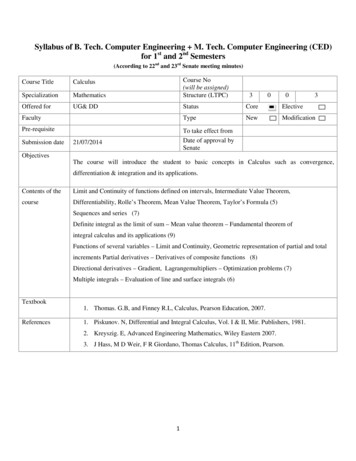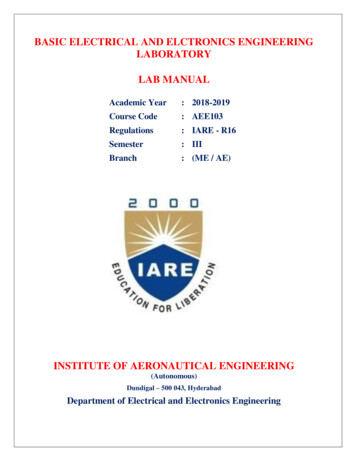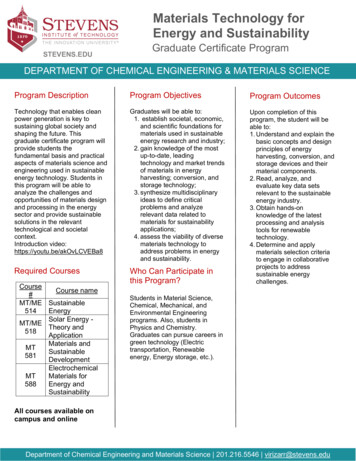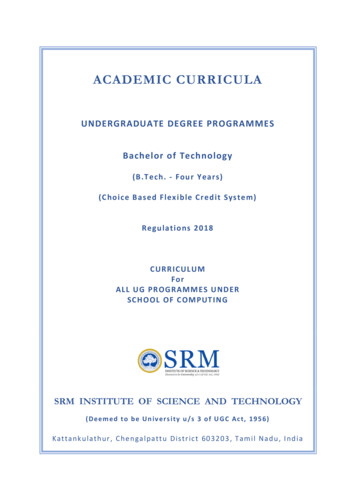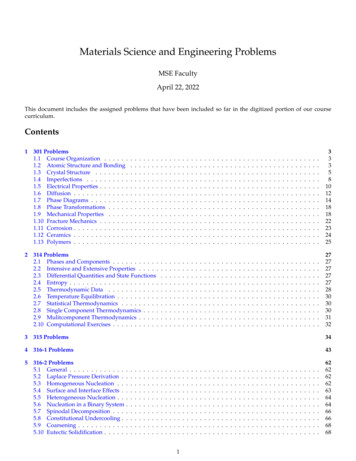
Transcription
Materials Science and Engineering ProblemsMSE FacultyApril 22, 2022This document includes the assigned problems that have been included so far in the digitized portion of our coursecurriculum.Contents12301 Problems1.1 Course Organization . . . . . .1.2 Atomic Structure and Bonding1.3 Crystal Structure . . . . . . . .1.4 Imperfections . . . . . . . . . .1.5 Electrical Properties . . . . . . .1.6 Diffusion . . . . . . . . . . . . .1.7 Phase Diagrams . . . . . . . . .1.8 Phase Transformations . . . . .1.9 Mechanical Properties . . . . .1.10 Fracture Mechanics . . . . . . .1.11 Corrosion . . . . . . . . . . . . .1.12 Ceramics . . . . . . . . . . . . .1.13 Polymers . . . . . . . . . . . . .33358101214181822232425314 Problems2.1 Phases and Components . . . . . . . . . . .2.2 Intensive and Extensive Properties . . . . .2.3 Differential Quantities and State Functions2.4 Entropy . . . . . . . . . . . . . . . . . . . . .2.5 Thermodynamic Data . . . . . . . . . . . .2.6 Temperature Equilibration . . . . . . . . . .2.7 Statistical Thermodynamics . . . . . . . . .2.8 Single Component Thermodynamics . . . .2.9 Mulitcomponent Thermodynamics . . . . .2.10 Computational Exercises . . . . . . . . . . .2727272727283030303132.3315 Problems344316-1 Problems435316-2 Problems5.1 General . . . . . . . . . . . . .5.2 Laplace Pressure Derivation .5.3 Homogeneous Nucleation . .5.4 Surface and Interface Effects .5.5 Heterogeneous Nucleation . .5.6 Nucleation in a Binary System5.7 Spinodal Decomposition . . .5.8 Constitutional Undercooling .5.9 Coarsening . . . . . . . . . . .5.10 Eutectic Solidification . . . . .1.6262626263646466666868
5.115.125.135.145.156Eutectoid TransormationsTransitional Phases . . . .TTT diagrams . . . . . . .Mineralization . . . . . . .Review Questions . . . . .6970717172332 Problems6.1 Course Organization . . . . . . . . . . . . .6.2 The Stress Tensor . . . . . . . . . . . . . . .6.3 Strains . . . . . . . . . . . . . . . . . . . . .6.4 Typical Moduli . . . . . . . . . . . . . . . .6.5 Matrix Representation of Stress and Strains6.6 Other Linear Properties . . . . . . . . . . . .6.7 Yield Criteria . . . . . . . . . . . . . . . . . .6.8 Strengthening Mechanisms . . . . . . . . .6.9 Contact Mechanics . . . . . . . . . . . . . .6.10 Nanoindentation . . . . . . . . . . . . . . .6.11 Fracture Mechanics . . . . . . . . . . . . . .6.12 Weibull Statistics . . . . . . . . . . . . . . .6.13 Viscoelasticity . . . . . . . . . . . . . . . . .6.14 Nonlinear Viscoelasticity and Creep . . . .7474747474757676788081828485877331 Problems908351-1 Problems1049351-2 Problems10910 361 Problems11 390 Problems11.1 Materials Selection in Mechanical Design11.2 Thermo-Calc . . . . . . . . . . . . . . . . .11.3 DICTRA . . . . . . . . . . . . . . . . . . .11.4 TC-PRISMA . . . . . . . . . . . . . . . . .11.4.1 . . . . . . . . . . . . . . . . . . . .11.4.2 . . . . . . . . . . . . . . . . . . . .111.2.116116118119119120120
Contents1301 Problems1.1Course Organization1)Send an email to Prof.Shull northwestern.edu) with the following information:andAlane(Alane.lim@k-1. Any background about yourself that you want to share.2. What you have enjoyed most and have found the most frustrating about your major.3. One particular aspect of materials science that you would like to learn more about this quarter.1.2Atomic Structure and Bonding2)Classify each of the following materials as to whether it is a metal, ceramic, or polymer. Justify each choice. (a.)brass; (b.) magnesium oxide (MgO); (c.) Plexiglass ; (d.) polychloroprene; (e.) boron carbide (B4 C); and (f.) steel.3)Site the difference between atomic mass and atomic weight.4)Silicon has three naturally occurring isotopes: 92.23% of 28 Si, with an atomic weight of 27.9769 amu, 4.68% of 29 Si,with an atomic wight of 28.9738 amu, and 3.69% of 30 Si, with an atomic weight of 29.938 amu. On the basis of these data,confirm that the average atomic weight of Si is 28.09.5)Indium has two naturally occurring isotopes: 113 In, with an atomic weight of 112.904 amu, and 115 In, with anatomic weight of 114.904 amu. If the average atomic weight for In is 114.818 amu, calculate the fraction-of-occurrencesof these two isotopes.6)Address the following concepts concerning atomic mass.1. How many grams are there in one amu of material?2. Mole, in the context of this book, is taken in units of gram-mole. On this basis, how many atoms are there in apound-mole of a substance?7)Relative to electrons and electronic states, what does each of the four quantum numbers specify?8)Give the electron configurations for the following ions: P5 , P3 , Sn4 , Se2 , I and Ni2 .9)Potassium iodide (KI) exhibits predominately ionic bonding. The K and I ion have electron structures that areidentical to which two inert gases?10)Without consulting Callister Figure 2.8 or Table 2.2, determine whether each of the following atomic electronconfigurations is an inert gas, a halogen, an alkali metal, an alkaline earth metal, or a transition metal. List the numberof valence electrons for each atom (except for the transition metals). Justify your choices.1. 1s2 2s2 2p6 3s2 3p52. 1s2 2s2 2p6 3s2 3p6 3d7 4s23. 1s2 2s2 2p6 3s2 3p6 3d10 4s2 4p64. 1s2 2s2 2p6 3s2 3p6 4s15. 1s2 2s2 2p6 3s2 3p6 3d10 4s2 4p6 4d5 5s26. 1s2 2s2 2p6 3s23
11)The atomic radii of Mg2 and F- ions are 0.072 and 0.133 nm respectively.1. Calculate the force of attraction between the two ions at their equilibrium interionic separation (i.e., when the ionsjust touch one another).2. What is the force of repulsion at this same separation distance?12)The force of attraction between a divalent cation and a divalent anion is 1.67 10 8 N. If the ionic radius of thecation is 0.080 nm, what is the anion radius?Here we’re provided with the two pieces of information: the force of attraction between a cation/anion pair and thecation’s atomic radius. With this information and an understanding of the Coulomb interaction we can calculate theanion radius.The force of attraction between two isolated ions is defined by Callister Eq. 2.13:13)The net potential energy between two adjacent ions, EN , may be represented by the sum of Callister equations2.9 and 2.11. That is:AB(1.1)EN nrrDetermine the equilibrium ionic bond energy, E0 , in terms of the parameters A, B, and n. Note that equilibrium occurswhen the net force on the ions is zero. Use the following procedure:1. Differentiate EN with respect to r to acquire the expression for the interatomic force.2. Assume two adjacent ions a EN versus r is minimum at E0 .3. Solve for r in terms of A, B, and n, which yields r0 , the equilibrium interionic spacing.4. Determine the expression for E0 by substituting r0 into the equation.14)For an Na -Cl- ion pair, attractive and repulsive energies (E A and ER , respectively), depends on the distancebetween ions:1.44 eV · nmr7.32 10 6 eV · nm8ER r8EA (1.2)(1.3)1. Superimpose on a single plot (by hand or using plotting software) E A , ER , and the net energy EN up to r 1.0 nm.Hint: You may have to truncate the plot on the y-axis for good visualization.2. From this plot, derive the equilibrium spacing, r0 and the magnitude of the bonding energy, E0 at the equilibriumspacing.3. Now consider instead a K -Cl- bonding pair. The K ion is larger, which changes the repulsive term ER to be:ER 5.80 10 6 eV nm9r9Without plotting the new EN , how do you expect E0 and r0 to change for the K -Cl- ion pair?15)Briefly discuss the main differences between 1.) ionic, 2.) covalent, and 3.) metallic bonding.4(1.4)
16)Plot the bonding energy vs melting temperature for the following metals.ElementHgAlAgWBonding Energy (kJ/mol)62330282850Melting Temperature ( C)-396609623414Using this plot, approximate the bonding energy for molybdenum, which has a melting temperature of TM 2617 C.17)Compute the percent ionicity (&IC) of the interatomic bonds for each of the following compounds: MgO, GaP,CsF, CdS, and FeO. Which would we consider primarily ionic, and which would we consider primary covalent?Semiconductors typically possess covalent bonds - which of the compounds above do you expect is (are) used as insemiconductor applications?18)What are the predominant type(s) of bonding would be expected for each of the following materials: solid xenon,calcium fluoride (CaF2 ), bronze (a copper alloy), cadmium telluride (CdTe), rubber, and tungsten?1.3Crystal StructureThe body-centered cubic (BCC) crystal structure is shown below in Fig. 1.1 Demonstrate the following: 1. The unit cell length (also referred to as a lattice parameter) is a 4r/ 3, where r is the atomic radius.19)2. The atomic packing factor (APF) is 0.68.Figure 1.1: The BCC structure.This is the first problem you have in navigating and performing calculations on basic unit cells. This process is identicalfor all single-element unit cells (practice more if you need, see suggested problems) and you should be able to performit for any cubic unit cell. In this case, visualizing how the atoms stack in the close-packed (touching) {111} directions iscritical as well as some simple geometry and vector calculations.20)Molybdenum has a BCC crystal structure, an atomic radius of 0.1363 nm, and an atomic weight of 95.94 g/mol.Compute and compare its theoretical density with the experimental value found inside the front cover of the Callisterbook.5
21)Strontium has an FCC crystal structure, an atomic radius of 0.215 nm, and an atomic weight of 87.62 g/mol.Calculate the theoretical density for Sr. Make sure to use intuitive units (not g/nm3 ).22)Calculate the radius of a palladium (Pd) atom,given that Pd has an FCC crystal structure, a density of ρPd 12.0g/cm3 , and an atomic weight of APd 106.4 g/mol.23)The atomic weight, density, and atomic radius for the three hypothetical alloys are listed in Table 1.1. For each,determine whether its crystal structure is FCC, BCC, or simple cubic (SC) and then justify your determination. Only workon this problem until you understand the concepts. It can get tedious.AlloyABCAtomic Weight (g/mol)43.1184.491.6Density (g/cm3 )6.4012.309.60Atomic radius (nm)0.1220.1460.137Table 1.1: Alloy Properties24)Iron (Fe) undergoes an allotropic transformation at 912 o C. Upon heating it transitions from a BCC (α phase) toan FCC (γ phase). Accompanying this transformation is a change in the atomic radius of Fe – from rBCC 0.12584 nmto rFCC 0.12894 nm – and, in addition, a change in density (and volume). Compute the percentage volume changeassociated with this transformation. Does the volume increase or decrease?25)For the tetragonal crystal system (a b 6 c, α β γ 90 ), identify the lattice directions that are equivalentto the (a) [011] and the (b) [100] directions, respectively.26)Determine the indices for the directions shown in the following cubic unit cell (only do this problem until youunderstand the process):27)Determine the indices for the directions shown in the cubic unit cell below Fig. 1.2(a). Do as much of this problemas you need to understand the process.6
(a)(b)Figure 1.2: Some crystallographic directions (a) and planes (b)28)For the tetragonal crystal system (a b 6 c, α β γ 90 ), identify the lattice directions that are equivalentto the (a) [011] and the (b) [100] directions, respectively.29)Determine the Miller indices for the planes shown in the following unit cell:30)Determine the Miller indices for the planes shown in the following unit cell:7
31)For the tetragonal crystal system (a b 6 c, α β γ 90 ), identify the lattice directions that are equivalentto the (a) [011] and the (b) [100] directions, respectively.32)Would you expect a material in which the atomic bonding is predominantly ionic is in nature to be more likelyor less likely to form a noncrystalline solid upon solidification than a covalent material? Why? (See Callister Section 2.6)33)Fig. 1.3 shows two tiled patterns. In each, draw a 2D unit cell — the simplest repeat unit in these patterns. Note— there are more than one possible answers.(a)(b)Figure 1.3: Periodic tiled patterns. From Baelde (Own work) [CC BY-SA 3.0 a Wikimedia Commons.Similar problems: Google Image Search “Periodic Tessalation” and try some of those images. Warning — Google searcheswill not always yield a periodic tile. so be careful not to waste your time.34)Describe the differences in short-range order (bonding, local geometry) and long-range order (crystallinity) between crystalline and non-crystalline materials.1.4Imperfections35)For some hypothetical metal, the equilibrium number of vacancies at 900 o C is 2.3 1025 m 3 . If the density andatomic weight of this metal are 7.40 g/cm3 and 85.5 g/mol, respectively, calculate the fraction of vacancies for this metalat 900 o C.36)Calculate the activation energy for vacancy formation in aluminum given that the equilibrium number of vacancies at 500 C (773 K) is 7.57 1023 m 3 . The atomic weight and density (at 500 C) for aluminum are, respectively,26.98 g/mol and 2.62 g/cm3 .37)For both FCC and BCC crystal structures, there are two different types of interstitial sites. In each case, one siteis larger than the other and is normally occupied by impurity atoms. For FCC, this larger one is located at the center ofeach edge of the unit cell; it is termed an octahedral interstitial site. On the other hand, with BCC the larger site type isfound at 0 12 14 positions - that is, lying on {100} faces and situated midway between two unit cell edges on this face andone-quarter of the distance between the other two unit cell edges; it is termed a tetrahedral interstitial site. For both FCCand BCC crystal structures, compute the radius r of an impurity atom that will just fit into one of these sites in terms ofthe atomic radius R of the host atom.38)Derive the following equations: (a) Equation 4.7a (b) Equation 4.9a (c) Equation 4.10a (d) Equation 4.11b8
39)Atomic radius, crystal structure, electronegativity, and the most common valence are given in the following tablefor several elements; for those that are nonmetals, only atomic radii are indicated.ElementNiCHOAgAlCoCrFePtZnAtomic Radius 490.12410.13870.1332Crystal StructureFCCElectronegativity1.8Valence 2FCCFCCHCPBCCBCCFCCHCP1.91.51.81.61.82.21.6 1 3 2 3 2 2 2Which of these elements would you expect to form the following with nickel at room temperature?:1. a substitutional solid solution having complete solubility2. a substitutional solid solution of incomplete solubility3. an interstitial solid solution40)(a)Compute the radius r of an impurity atom that will just fit into an FCC octahedral site in terms of the atomicradius R of the host atom (without introducing lattice strains).(b) Repeat part(a) for the FCC tetrahedral site. (Note: You may want to consult Callister Figure 4.3a.)41)(a) For BCC iron, compute the radius of a tetrahedral interstitial site. (For this problem, you need the result ofProblem 4.9, which is r 0.291R, where R is the radius of the atoms in the FCC unit cell and r is the tetrahedron radius.You should do 4.9 if you don’t understand how to find this.)42)What is the composition, in weight percent, of an alloy that consists of 5 at% Cu and 95 at% Pt?43)Molybdenum forms a substitutional solid solution with tungsten. Compute the number of molybdenum atomsper cubic centimeter for a molybdenum-tungsten alloy that contains 16.4 wt percent Mo and 83.6 wt percent W. Thedensities of pure molybdenum and tungsten are 10.22 and 19.30 g/cm3, respectively.44)Calculate the number of atoms per cubic meter in Pb.45)Cite the relative Burgers vector-dislocation line orientations for edge, screw, and mixed dislocations.46)For an FCC single crystal, would you expect the surface energy for a (100) plane to be greater or less than that fora (111) plane? Why? (Note: You may want to consult the solution to Problem 3.60 at the end of Chapter 3.)47)(a)For a given material, would you expect the surface energy to be greater than, the same as, or less than the grainboundary energy? Why?(b) The grain boundary energy of a small angle grain boundary is less than for a high-angle one. Why is this so?48)Aluminum-lithium (Al-Li) alloys have been developed by the aircraft industry to reduce the weight and improvethe performance of its aircraft. A commercial aircraft skin material having a density of 2.47 g/cm3 is desired. Computethe concentration of Li (in wt%) that is required.9
1.549)Electrical PropertiesConsider a cylindrical silicon specimen 7.0 mm in diameter and 57 mm in length.1. A current of 0.25 A passes along the specimen in the axial direction. A voltage of 24 V is measured across twoprobes that are separated by 45 mm. What is the electrical conductivity of the specimen?2. Compute the resistance over the entire 57 mm of the specimen.50)A plain carbon steel wire 3 mm in diameter is to offer a resistance of no more than 20 Ω. Using Callister Table18.1, compute the maximum wire length.51)Consider an aluminum wire 5 mm in diameter and 5 m in length.1. Using the data in Callister Table 18.1, compute the resistance of the wire.2. What would be the current flow if the potential drop across the ends of the wire is 0.04 volt?3. What is the current density?4. What is the magnitude of the electric field across the ends of the wire?52)Recall electronic band structure as discussed in the book and lecture.1. How does the electron structure of an isolated atom differ from that in a solid?2. In terms of electron energy band structure, discuss the reasons for the difference in electrical conductivity amongmetals, semiconductors, and insulators.53)Briefly state what is meant by the drift velocity and mobility of a free electron.54)Consider free electrons moving in silicon at room temperature.1. Calculate the drift velocity of the electrons when the magnitude of the electric field is 500 V/m.2. Under these circumstances, how long does it take an electron to traverse a 25-mm length of crystal?55)Silicon and germanium are two of the most technologically relevant semiconducting materials.1. Using the data presented in Callister Fig. 18.16, determine the number of free electrons per atom for intrinsic germanium and silicon at room temperature (298 K). The densities for Ge and Si are 5.32 and 2.33 g/cm3 , respectively.2. Now, explain the difference in these free-electron-per-atom values.56)For intrinsic semiconductors, the intrinsic carrier concentration ni , depends on temperature as follows: Egni exp 2k B Tor, by taking the log of both sides of the equation:ln ni Eg2k B TE1. A plot of ln ni versus 1/T will therefore be linear and yield a slope of 2kg . This is provided for you below for bothBSi and Ge. Using this information determine the band gap energies for silicon and germanium and compare thesevalues with those in Callister Table 18.3.10
2. Where does the factor of 2 in the denominator come from in these equations?(a.)(b.)Figure 1.4: An Arrhenius plot relating ni and T for (a.) Si and (b.) Ge.57)Is it possible for compound semiconductors to exhibit intrinsic behavior? Explain your answer.58)For each of the following pairs of semiconductors, decide which has the smallest band gap energy, Eg , and citethe reason for your choice.1. C (diamond) and Ge2. AlP and InAs3. GaAs and ZnSe4. ZnSe and CdTe5. CdS and NaCl59)For each impurity element in the following table , predict whether it will act as a donor or an acceptor whenadded to the indicated semiconducting material. Assume the that impurity elements are bCdSZnTeFigure 1.5: Electronegativity values for the elements.11
60)A concentration of 1024 As atoms per cubic meter have been added to germanium to form an extrinsic semiconductor. At room temperature, virtually all of the As atoms can be considered to be ionized (i.e., one charge carrier existsfor each As atom).1. Is this material n-type or p-type?2. Calculate the electrical conductivity of this material, assuming electron and hole mobilities of 0.1 and 0.05 m2 /V s,respectively.61)Calculate the conductivity of intrinsic silicon at 80 C.62)Compare the temperature dependence of the conductivity for metals, intrinsic, and extrinsic semiconductors.Briefly explain the difference in behavior.63)Calculate the room-temperature electrical conductivity of silicon that has been doped with 1023 m 3 carriers ofarsenic atoms.64)Briefly describe electron and hole motions in a p-n junction for forward and reverse biases. How do these lead torectifying behavior?65)1.666)Summarize Matthiessen’s rules. That is, what are the factors that influence resistivity in metals?DiffusionConsider different diffusion mechanisms in solids:1. Compare interstitial and vacancy atomic mechanisms for diffusion.2. Cite two reasons why interstitial diffusion is normally more rapid than vacancy diffusion.67)Consider the diffusion of carbon in BCC iron (α-Fe).1. What diffusion mechanism to you expect for C in α-Fe: interstitial or substitutional? Why?2. Assuming that diffusion occurs via adjacent tetrahedral sites in α-Fe, what family of crystallographic directionsdoes this diffusion take place? Refer to the figure below to recall the locations f the interstitial sites in a BCCmaterial.68)Consider the role of the driving force in diffusion:1. Briefly explain the concept of a driving force.2. What is the driving force for steady-state diffusion?12
69)A sheet of steel 2.5-mm thick has nitrogen atmospheres on both sides at 900 C and is permitted to achieve asteady-state diffusion condition. The diffusion coefficient for nitrogen in steel at this temperature is 1.85 10 10 m2 /s,and the diffusion flux is found to be 1.0 10 7 kg/m2 · s. Also, it is known that the concentration of nitrogen in the steelat the high-pressure surface is 2 kg/m3 . How far into the sheet from this high-pressure side will the concentration be0.5 kg/m3 ? Assume a linear concentration profile.70)A sheet of BCC iron 2 mm thick was heated to 675 C exposed to a carburizing gas atmosphere on one sideand a decarburizing atmosphere on the other. After reaching steady-state, the iron was then quickly cooled to roomtemperature and the carbon concentrations on the two surfaces were determined to be 1.18 kg/m3 and 0.535 kg/m3 .Compute the diffusion coefficient if the diffusion flux is 7.36 10 9 kg/(m2 · s). (You will need to convert wt% to massdensity (Callister Eq. 4.9). Assume that the density of carbon is 2.25 g/cm3 .)71)Show that x2BCx exp 4DtDtis a solution to the Fick’s second law: C 2 C D 2. t xHere, the parameters B and D are constant with respect to both x and t.72)Determine the carburizing time necessary to achieve a carbon concentration of 0.30 wt% at a position 4 mm intoan iron-carbon alloy that initially contains 0.10 wt% C. The surface concentration is to be maintained at 0.90 wt% C, andthe treatment is to be conducted at 1100 C. Use the diffusion data for γ-Fe in Table 5.273)Nitrogen from a gaseous phase is to be diffused into pure iron at 675 C. If the surface concentration is maintainedat 0.2 wt% N, what will be the concentration 2 mm from the surface after 25 h? The diffusion coefficient for nitrogen iniron at 675 C is 2.8 10 11 m2 /s.74)Cite the values of the diffusion coefficients for interdiffusion of carbon in both α-iron (BCC) and γ-iron (FCC) at900 Â C Which is larger and why?75)The diffusion coefficients for nickel in iron are given at two temperatures, as follows:T (K)14731673D (m2 /s)2.2 10 154.98 10 141. Determine the values of D0 and the activation energy,Qd .2. What is the magnitude of D at 1300 C (1573 K)?76)The diffusion coefficients for carbon in nickel are given at two temperatures, as follows:T C600700D (m2 /s)5.5 10 143.9 10 131. Determine the values of D0 and Qd .2. What is the magnitude of D at 850 C?77)The figure below shows a plot of the base-10 logarithm of the diffusion coefficient vs reciprocal of the absolutetemperature for the diffusion of gold in silver. Determine the values for the activation energy and the preexponential.13
78)For the predeposition heat treatment of a semiconducting device, gallium atoms are to be diffused into siliconat a temperature of 1150 C for 2.5 hrs. If the required concentration of Ga at a position 2 µm below the surface is8 1023 atoms/m3 , compute the required surface concentration of Ga. Assume the following:1. The surface concentration remains constant2. The background concentration is 2 1019 Ga atoms/m33. Preexponential and activation energies are 3.74 10 5 m2 /s and 3.39 eV/atom, respectively.79)Suppose you are considering two carburization processes for steel. Assume that both processes give materialswith identical performance characteristics, and that your goal is to minimize the processing time. Process A requires thatthe carbon diffuse twice as far into the iron as process B. The carbon diffusion coefficient for process A is 3 times as largeas for process B. Which process do you choose, and why?1.780)Phase DiagramsAt 100 C, what is the maximum solubility of the following:1. Pb in Sn2. Sn in PbFigure 1.6: Pb-Sn Phase Diagram81)What thermodynamic condition must be met for a state of equilibrium to exist?82)A 50 wt% Ni-50 wt% Cu alloy is slowly cooled from 1400 C to 1200 C.1. At what temperature does the first solid phase form?2. What is the composition of this solid phase?3. At what temperature does the liquid solidify?4. What is the composition of this last remaining liquid phase?14
Figure 1.7: Cu-Ni Phase Diagram83)A 40 wt% Pb-60 wt% Mg alloy is heated to a temperature within the α Liquid phase region. If the mass fractionof each phase is 0.5, then estimate:1. The temperature of the alloy2. The compositions of the two phases in weight percentFigure 1.8: Mg-Pb phase diagram.84)A copper/silver alloy is heated to 900 C and is found to consist of α and liquid phases. If the mass fraction ofthe liquid phase is 0.68, determine:15
1. The composition of both phases, in both weight percent and atom percent.2. The composition of the alloy, in both weight percent and atom percent.Figure 1.9: Cu/Ag Phase Diagram.85)A 60 wt percent Pb-40 wt percent Mg alloy (see Fig. 1.8) is rapidly quenched to room temperature from anelevated temperature in such a way that the high-temperature microstructure is preserved. This microstructure is foundto consist of the α phase and Mg2 Pb, having respective mass fractions of 0.42 and 0.58. Determine the approximatetemperature from which the alloy was quenched.86)For a 76 wt% Pb-24 wt% Mg alloy (see Fig. 1.8), make schematic sketches of the microstructure that would beobserved for conditions of very slow cooling to the following temperatures: 575 C, 500 C, 450 C, and 300 C. Labelall phases and indicate their approximate compositions.87)For the tin/gold system, specify the temperature-composition points at which all eutectics, eutectoids, peritectics,and peritectoid phase transformations occur. Also, for each, write the reaction upon cooling. Note, β, γ, and δ are labelingthe intermetallic phases which are indicated by vertical lines on the phase diagram.16
Figure 1.10: Sn/Au Phase Diagram88)Compute the mass fractions of α-ferrite and cementite Fe3 C that in pearlite, formed by cooling steel with a composition equal to the eutectoid composition.Figure 1.11: Fe-C Phase Diagram89)3.5 kg of austenite containing 0.
21) Strontium has an FCC crystal structure, an atomic radius of 0.215 nm, and an atomic weight of 87.62 g/mol. Calculate the theoretical density for Sr. Make sure to use intuitive units (not g/nm3). 22) Calculate the radius of a palladium (Pd) atom,given that Pd has an FCC crystal structure, a density of r Pd 12.0 g/cm3, and an atomic weight of A Pd 106.4 g/mol.



